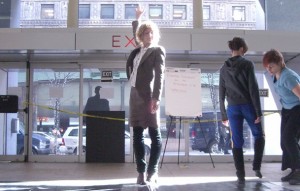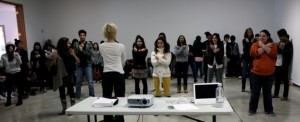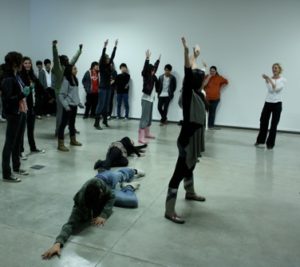Most lectures include a performative element where audience becomes participant. Each one is specific to location and situation, and can range from 1 hour to a series of days. Past lecture/workshops have included:
Performance Development for the Betterment of the Workplace (above), an improvisation workshop for office workers and others communicated through corporate speak which lends tools for expanding the experience of the workday through attention to repetitive movement present within it.
Performance Steps is a series of movements that can be taught to people of any experience level; existing survival tactics are taught from various sources already available to the public from U.S. Army Training manuals, hunter’s safety guides, legal choreography for civil disobedience, and what to do during a wild animal attack.
Other workshops may be more open-ended, aimed specifically for the context. The activation of public space through movement, possibilities of transformation of experience through bodily awareness, and individual vs. communal movement experiments are broad themes that may be explored via different strategies. Workshop materials are built to meet the needs, interest and experience of the group whether visual artists, dancers, students or the general population.
Please see Teaching page for long-term positions.
__________________________________________________________________________
“How to Survive, a weekend-long workshop organized by Los Angeles–based artists Alyse Emdur and Michael Parker for High Desert Test Sites’ (HDTS) “New Everyday Life” lecture and workshop series, dealt irreverently with the model of ameliorative self-help, while pointing out fluctuating and culturally relative notions of necessity and survival. Demonstrations offered instruction in activities ranging from the informative to the absurd and touched on a variety of human needs, including food, communication, exercise, leisure, and energy.1 Each activity, whether it was building a solar oven or distilling moonshine, was informed by cognizance of both the fables that shape and the regulations that codify it……… For the second workshop session, Flora Wiegmann, participants used military training manuals and wildlife safety instructions as source materials for teaching survival choreography. She guided participants through movements that enable soldiers to communicate directions from a distance and gestures that allow hikers and swimmers to escape animal confrontations. After learning the motions, pairs of participants used them to direct each other down a dirt road and into a dry creek. One directive, indicated to distant partners by pummeling the air with one fist, instructed them to jab at invisible shark gills or curl up on the sand. Transplanted into a near-danger-free context, signals intended to facilitate survival became forms for interaction that required surrendering self-consciousness. The activity felt like playing pretend, a game defined by the excitement and hazard of rules made up on the spot. It was also reminiscent of team charades, trust-falls or other exercises from corporate retreats that are mandated with an eye toward increased productivity.” by Elise Edumur






